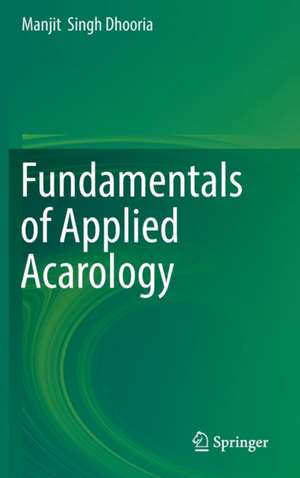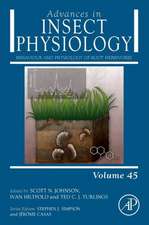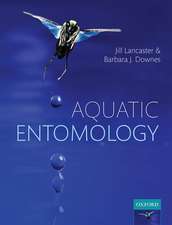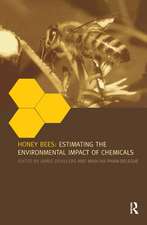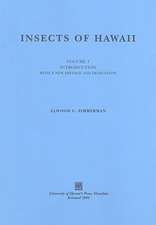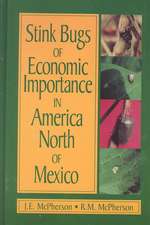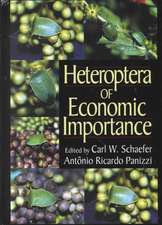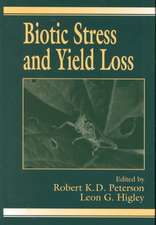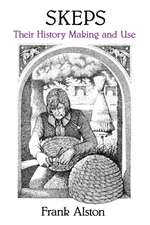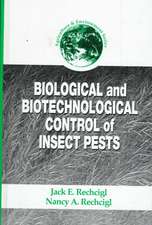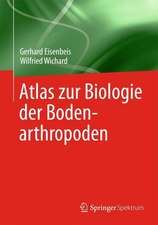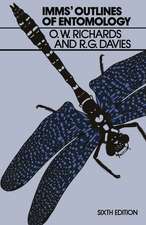Fundamentals of Applied Acarology
Autor Manjit Singh Dhooriaen Limba Engleză Hardback – 21 dec 2016
Acarology - the study of mites and ticks, is a subdiscipline of Zoology, and is many times considered in the field of Entomology (the study of insects). Mites and ticks are distributed throughout the world and inhabit almost every ecosystem (both terrestrial and aquatic) including grassland soils. More than 55,000 species of mites and ticks are already described. Mites and ticks directly affects humans as pests of different crops, fruit plants, vegetable crops and field crops; as parasites of human beings, veterinary animals, poultry and pets; pests of stored grains and other products; mushrooms and cheese; and as parasites of honeybees. Mite infestations are responsible for economic losses worth billions of dollars in terms of reduced crop yields and lowered quality of produce. Many species of mites serve as vectors of various plant diseases; some species of ticks cause losses through blood feeding and by transmitting many diseases among man and animals. House-dust mite allergies, and tick bite allergies are also common in many parts of the world.
Present Book, "Fundamentals of Applied Acarology," is written keeping in view non-availability of any standard text dealing in different aspects of acarology at one place. Separate chapters in this book are devoted to Importance of Acarology, Historical account, acarine technology, morphology and anatomy of Acari; Feeding, Development and Reproduction. Molecular developments in relation to mites and ticks are also discussed. Role of mites and ticks in Quarantines of plants and animals; forensic/criminal investigations; and importance of accidental acarophagy are discussed in detail. Safe usage of pesticides based on their mode of action (IRAC’s Groups), development of acaricide resistance and measures to mitigate it are discussed. Mite pests of fruit trees, vegetable plants, and floricultural plants; field crops; mite problems in greenhouses/polyhouses; and mite problems encountered under organic cultivation of plants; and their management through minimum usage of pesticides are emphasized. Role of different predaceous mites in controlling plant pests like thrips, aphids and scale insects is elaborately discussed. Biological control of phytophagous mites is discussed in detail. Different animal parasitic mites and ticks are discussed from veterinary and medical point of view.
At the end of each chapter, many important references for further reading; and Electronic References (ER) in the form of youtube links and other weblinks are given to understand fully how these tiny creatures look like; behave, feed and reproduce; nature of damage they cause to plants and animals; and measures to mitigate them. Weblinks will stimulate interest in the readers for more information about different mites and ticks. Theknowledge contained in the book may prove as best material for "General and Applied Acarology" course for graduate and post-graduate levels, teachers and researchers in entomology, pest control advisors, professional entomologists, pesticide industry managers, policy planners, and others having interest in mites and ticks.| Toate formatele și edițiile | Preț | Express |
|---|---|---|
| Paperback (1) | 1226.24 lei 6-8 săpt. | |
| Springer Nature Singapore – 15 iul 2018 | 1226.24 lei 6-8 săpt. | |
| Hardback (1) | 1232.41 lei 6-8 săpt. | |
| Springer Nature Singapore – 21 dec 2016 | 1232.41 lei 6-8 săpt. |
Preț: 1232.41 lei
Preț vechi: 1502.94 lei
-18% Nou
Puncte Express: 1849
Preț estimativ în valută:
235.82€ • 256.96$ • 198.71£
235.82€ • 256.96$ • 198.71£
Carte tipărită la comandă
Livrare economică 23 aprilie-07 mai
Preluare comenzi: 021 569.72.76
Specificații
ISBN-13: 9789811015922
ISBN-10: 9811015929
Pagini: 466
Ilustrații: XXIII, 470 p. 158 illus., 34 illus. in color.
Dimensiuni: 155 x 235 x 27 mm
Greutate: 0.87 kg
Ediția:1st ed. 2016
Editura: Springer Nature Singapore
Colecția Springer
Locul publicării:Singapore, Singapore
ISBN-10: 9811015929
Pagini: 466
Ilustrații: XXIII, 470 p. 158 illus., 34 illus. in color.
Dimensiuni: 155 x 235 x 27 mm
Greutate: 0.87 kg
Ediția:1st ed. 2016
Editura: Springer Nature Singapore
Colecția Springer
Locul publicării:Singapore, Singapore
Cuprins
1. Acarology and its Importance.- 2. Historical Account of Acarology.- 3. Acarine Technology.- 4. Morphology and Anatomy of Acari.- 5. Classification of Subclass Acari.- 6. Important Acari Families.- 7. Feeding, Development and Reproduction.- 8. Molecular Biology and Acarology.- 9. Water Mites.- 10. Soil Mites.-11. Quarantine Acarology.- 12. Mite Pests of Horticultural Crops.- 13. Mite Pests of Field Crops.- 14. Mite Pests of Greenhouse Crops.- 15. Management of Mite Pests under Organic Farming.- 16. Mite Transmission of Plant Diseases.- 17. Mite Pests of Mushrooms.- 18. Mite Problems of Stored Foods.- 19. Mites Predaceous on Pests of Agriculture.- 20. Biological Control of Phytophagous Mites.- 21. Pesticides.- 22. Parasitic Mites on Honey Bees.- 23. Medical and Veterinary Acarology.- 24. Forensic Acarology.- 25. Accidental Acarophagy.- 26. Glossary
Notă biografică
Dr M. S. Dhooria was born in 1946 and did his B.Sc. in Agriculture in 1967,and M.Sc. in Entomology in 1969 from Punjab Agricultural University, Ludhiana(Punjab), India. In 1980, did Ph. D in Entomology from Indian Agricultural Research Institute(IARI),New Delhi (India)and did pioneering researches on mite pests of citrus. He was awarded Junior Research Fellowship in M.Sc., and Senior Research Fellowship in Ph. D studies by the Indian Council of Agricultural Research (ICAR),New Delhi. He has more than 36 years of experience in teaching, research and extension of entomology. He did research work on: Biology, Ecology, and control of phytophagous mites of Punjab. Published more than 125 research publications in different reputed journals. Contributed some book chapters and a booklet on Citrus Mites as a special publication of ICAR. Attended several national and international level workshops on different aspects of insects and mites. He is also a life fellow of Entomological Society of India, New Delhi; Indian Society for the Advancement of Insect Science, Ludhiana; and Acarological Society of India(ASI), Bangalore. Remained as Vice President of ASI for two terms. Friendship Forum of India, New Delhi, awarded him the Certificate of Honour and Gold Medal for his lifetime achievements in Entomology. Retired from active service in April 2006.
Textul de pe ultima copertă
Present Book, "Fundamentals of Applied Acarology," is written keeping in view non-availability of any standard text dealing in different aspects of acarology at one place. Separate chapters in this book are devoted to Importance of Acarology, Historical account, acarine technology, morphology and anatomy of Acari; Feeding, Development and Reproduction. Molecular developments in relation to mites and ticks are also discussed. Role of mites and ticks in Quarantines of plants and animals; forensic/criminal investigations; and importance of accidental acarophagy are discussed in detail. Safe usage of pesticides based on their mode of action (IRAC’s Groups), development of acaricide resistance and measures to mitigate it are discussed. Mite pests of fruit trees, vegetable plants, and floricultural plants; field crops;mite problems in greenhouses/polyhouses; and mite problems encountered under organic cultivation of plants; and their management through minimum usage of pesticides are emphasized. Role of different predaceous mites in controlling plant pests like thrips, aphids and scale insects is elaborately discussed. Biological control of phytophagous mites is discussed in detail. Different animal parasitic mites and ticks are discussed from veterinary and medical point of view.
At the end of each chapter, many important references for further reading; and Electronic References (ER) in the form of youtube links and other weblinks are given to understand fully how these tiny creatures look like; behave, feed and reproduce; nature of damage they cause to plants and animals; and measures to mitigate them. Weblinks will stimulate interest in the readers for more information about different mites and ticks. The knowledge contained in the book may prove as best material for "General and Applied Acarology" course for graduate and post-graduate levels, teachers and researchers in entomology, pest control advisors, professional entomologists, pesticide industry managers, policy planners, and others having interest in mites and ticks.
Caracteristici
Comprehensively provdes information on basic and applied aspects of Acarology Elucidates widespread applications of acarology in diverse fields of life Provides detailed account of pest management in varied crops Includes supplementary material: sn.pub/extras
